Thanksgiving is a time for traditions, and one of my favorites has always been pumpkin crescent rolls. Their festive flair and irresistible flavor make them a beloved staple at my holiday table.
This year, I decided to give this classic a wholesome twist with these Sourdough Einkorn Pumpkin Crescent Rolls. By swapping regular all-purpose flour for all-purpose einkorn flour, I added a nutty, rich depth to the rolls, paired perfectly with the subtle tang of sourdough and the warm earthiness of pumpkin.
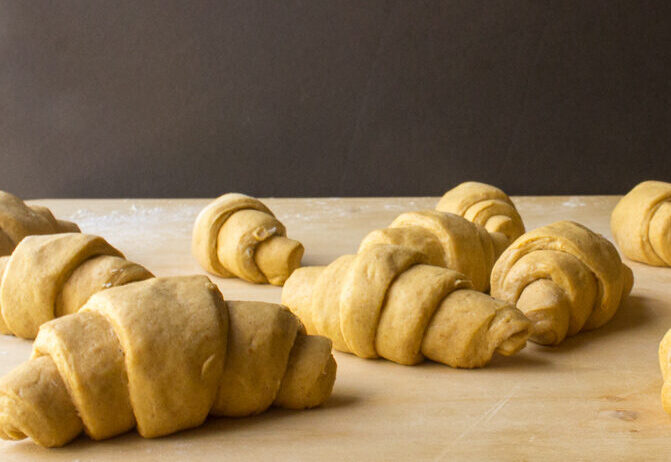
While I wasn’t sure how einkorn would perform in this recipe, the results were delightful—soft, flavorful crescents that honor tradition while bringing something fresh and healthier to the table.
Variations of my family’s favorite Pumpkin Crescent Rolls
- Pumpkin Crescent Rolls
- Sourdough Pumpkin Crescent Rolls
- Cinnamon Pumpkin Crescent Rolls
- Heritage Wheat Sourdough Pumpkin Crescent Rolls
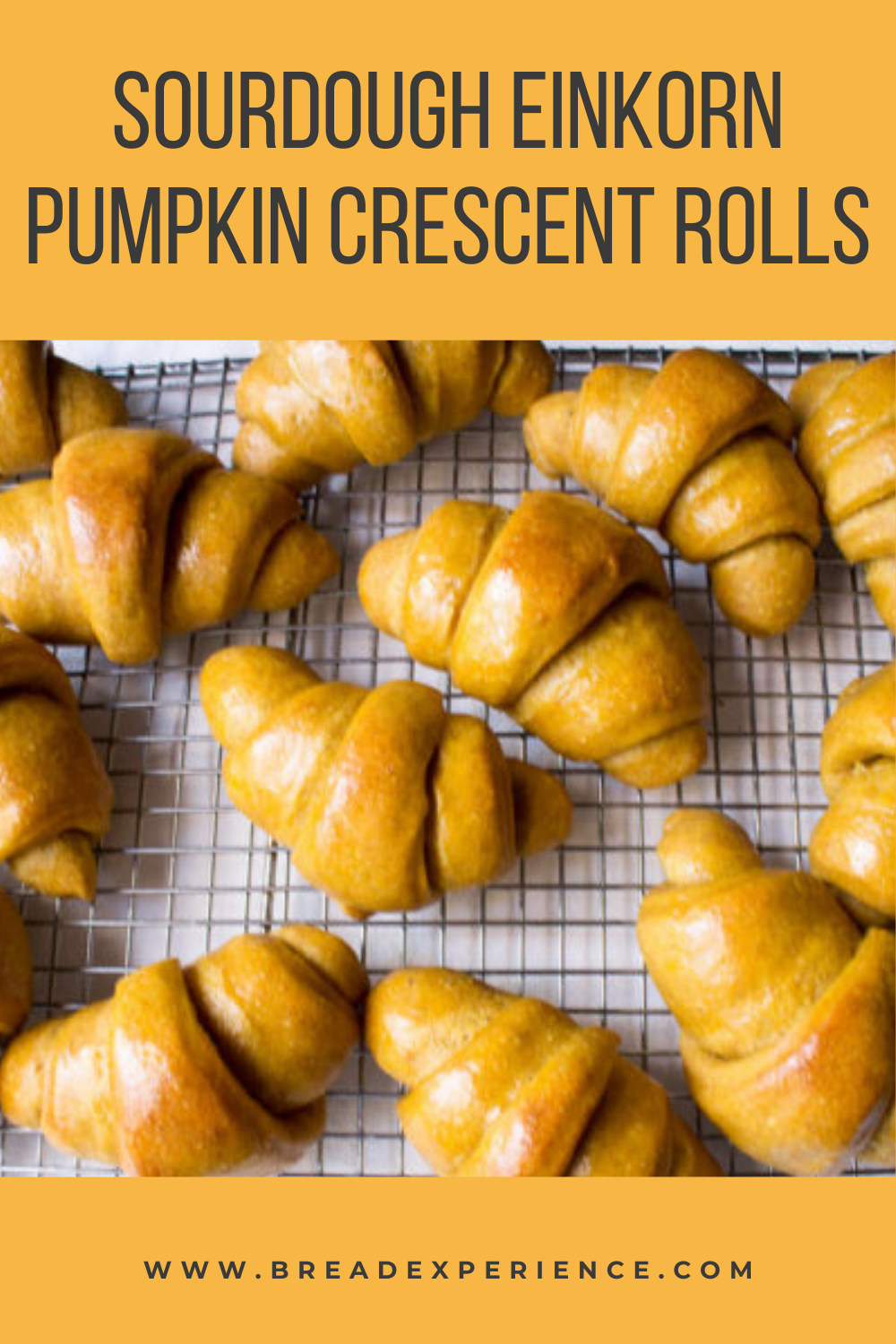
Using a stiff sourdough starter
When I converted these rolls to sourdough a couple of years ago, I didn’t need to add any additional water because my sourdough starter was 100% hydration, meaning I fed it with the same amount of flour and water.
This time, I used a stiff starter, meaning I fed it with more flour than water. I normally feed my einkorn sourdough starter with more flour than water because it keeps better in the refrigerator when it’s a bit stiffer.
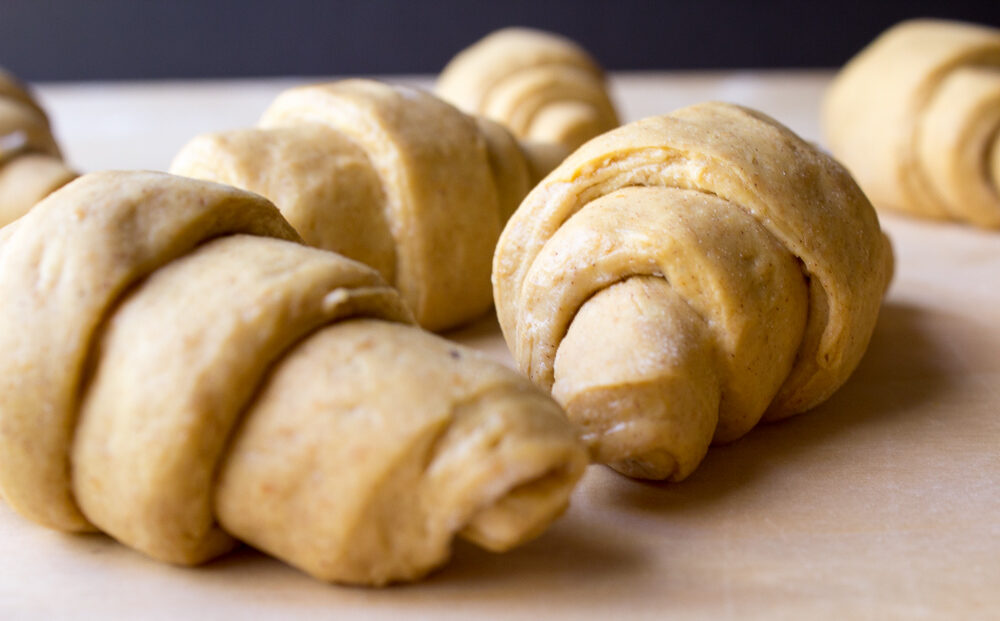
The type of einkorn flour you use makes a difference
As I learned when I made sourdough bread using different types of einkorn flour, depending on the type of einkorn flour you use, you may need to add more or less hydration.
For these sourdough einkorn pumpkin crescent rolls, I used Einkorn.com all-purpose flour. I knew from my tests that it starts dry, but after resting, it absorbs moisture and can become too wet if you add too much hydration to begin with.
Instead of adding more water right off the bat, I started with a drier dough and only added enough water (25 grams) to ensure there were no dry bits of flour. If you use a different type of einkorn all-purpose flour (such as Jovial Foods), you may need to add a little more water during mixing.
Updated Formula Nov 2021
I made several batches of these sourdough pumpkin crescent rolls recently and decided to tweak my original formula. For the updated version, I decreased the amount of sourdough from 225 grams to 100 grams, increased the flour to 500 grams from 400 grams, and added more water. I also adjusted the timing for the bulk fermentation. The edited formula is presented below.
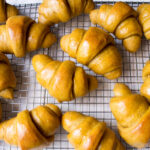
Sourdough Einkorn Pumpkin Crescent Rolls
- Total Time: 0 hours
- Yield: 16 rolls 1x
Description
Sourdough Einkorn Pumpkin Crescent Rolls make great rolls for Thanksgiving Dinner because they are festive, easy to make, and taste great.
Ingredients
100 grams (1/2 cup) Sourdough Starter, stiff
500 grams (~4 cups 1 Tbsp.) Einkorn flour, all-purpose
45 grams (1/4 cup) Brown sugar, packed
8 grams (1 1/2 tsp.) Salt, fine sea salt
6 grams (2 1/2 tsp.) Pumpkin Pie Spice
150–180 grams (2/3 to 3/4 cup) Water
100 grams (1/4 cup) Pumpkin puree
45 grams (1 large Egg) Egg, slightly beaten
56 grams (4 Tbsp.) Butter, cold, cut into small pieces
14 grams (1 Tbsp.) Butter, melted
Instructions
In a large bowl, whisk together the flour, brown sugar, salt, and pumpkin pie spice.
In a separate container, mix the sourdough, pumpkin puree, and egg with 100 grams of water. Pour the sourdough/pumpkin mixture over the flour and mix thoroughly using a Danish dough whisk, dough scraper, or wooden spoon. Gradually add in more water as needed to make a supple and workable dough that has no dry bits of flour.
Form the dough into a ball. Cover the bowl with a kitchen towel, or bees wrap and let rest for 20-30 minutes at room temperature.
Add in 3 tablespoons of butter, a little at a time, and thoroughly incorporate into the dough by squishing it between your fingers. It takes a few minutes to work the butter completely into the dough.
Place the dough on a lightly floured surface. Knead the dough for a few minutes until it is smooth and springy.
Original timeline: Place dough in a large bowl. Cover and let it sit at room temperature for at least 8 hours or overnight at room temperature. I let the dough rest overnight at room temperature (about 65 degrees F). This timeline works, especially if it fits better with your schedule. But I found the timeline below works well to reduce the sour notes the starter will impart if left to rest too long at a lower temperature.
Place the dough back in the bowl. Cover and let it rest at warm room temperature for 4-6 hours. Perform two stretch and folds in the dough the first hour – once every 30 minutes. Let the dough rest for the remaining 3-5 hours. (I used a proofer at 80 degrees F. ) If your kitchen is cooler, it may take longer. To keep the rolls from having sour undertones, proof them at a higher temperature for a shorter timeframe.
Place dough on a lightly floured surface. Knead a few times. Shape the dough into a ball, then flatten.
Roll the dough out into one 15-16-inch circle or two 7-8-inch circles for smaller rolls. Optionally, spread with the remaining 1 tablespoon of butter.
Cut into 16 or 32 wedges. Roll up each wedge, starting at the wide end.
Place the rolls on ungreased cookie sheets with points underneath and curve slightly. Cover and let rise 1-2 hours at warm room temperature or until double in size. If your kitchen is cold, it could take longer.
Baking Tip: At this point, you can let the rolls rise, and bake them right away, or if you want to bake them the next day, cover the shaped rolls and place them in the refrigerator overnight. The next morning or afternoon, let them warm up (1-2 hours) to room temperature before baking.
Preheat oven to 350 degrees F. Bake uncovered for a total of 14-17 minutes or until golden brown. Rotate the baking sheet(s) and switch racks (if needed) part way through the bake cycle for even baking. Remove the rolls from the oven to a wire rack and brush with melted butter, if desired.
Serve immediately after baking.
Notes
These rolls taste best warm, but they reheat well. Just wrap them in foil and heat in the oven (350 degrees F.) for about 10 minutes or so.
- Cook Time: 14 -17 min
- Category: Crescent Rolls
- Method: Sourdough
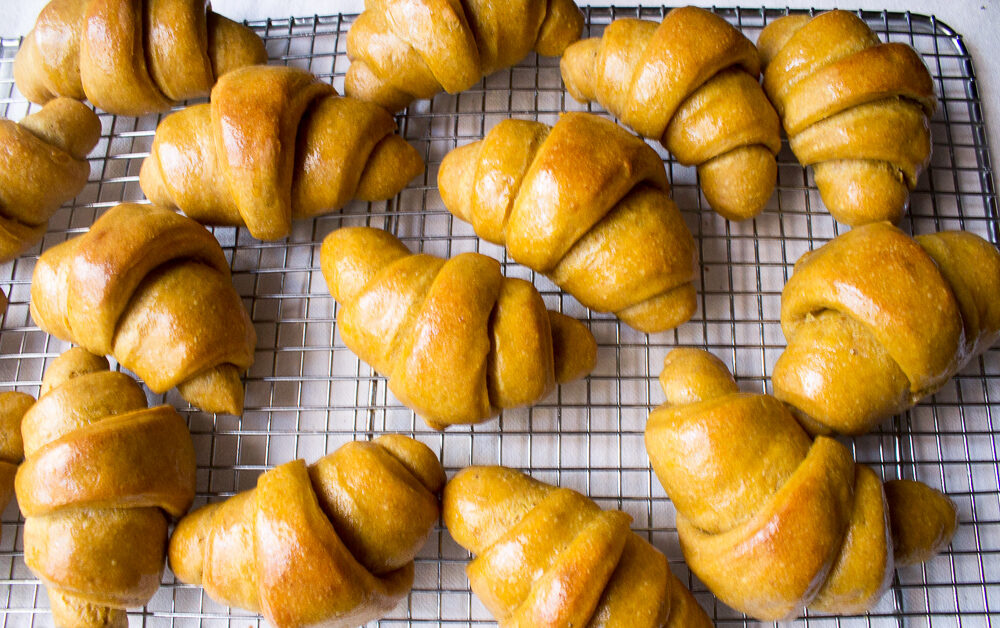
Happy Baking!
Cathy
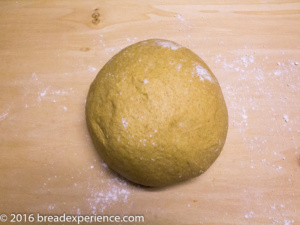
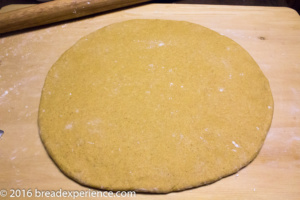
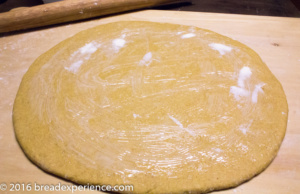
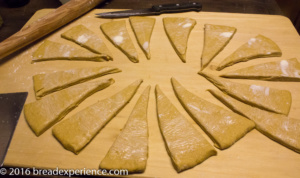
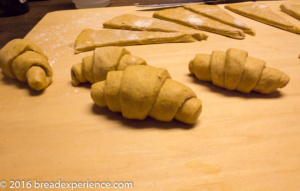
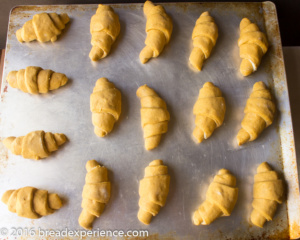
Liz says
Growing up my family always made what we called, “Butter-horn Rolls,” but in the recent 5 years my family (just my husband and kids) had to make a diet change and eliminate gluten. However, we are able to stomach and digest einkorn flour. Last year I made simple rolls with the einkorn but with yeast. This year my younger son requested the Butter-horn Rolls that my family makes… he’s only 9 and hasn’t had them since he was 5 I think so they must have made an impression on him! So here we go! Excited to try this out myself but as much as I want to add that pumpkin I’m not going to. Fingers crossed this seasoned baker of many flours will dominate and make some bomber rolls. Thank you for sharing this!!!
Cathy says
Hi Liz,
That’s great that your family is able to tolerate einkorn. Do let me know how your rolls turn out.
Happy Baking!
Cathy
Amy says
I am wanting to make these for Thanksgiving but don’t want to add the pumpkin. Do I need to adjust the liquid to compensate for the lack of pumpkin?
Cathy says
Yes, you will need to add more water if you plan to omit the pumpkin puree. I would start with 100 grams of water and gradually work it into the dough. You will probably need more water depending on whether your starter is 100% hydration or a stiff starter.
I made a couple of batches of these rolls recently. One batch was made with regular all-purpose flour and the other batch was made with einkorn all-purpose. For both batches, I decreased the amount of starter used to 100 grams instead of 225 grams. I really liked the results.
I plan to edit the formula based on my recent tests. Since I decreased the amount of starter, I increased the flour to 500 grams and used 150-180 grams of water. The greater amount was for the regular all-purpose flour.